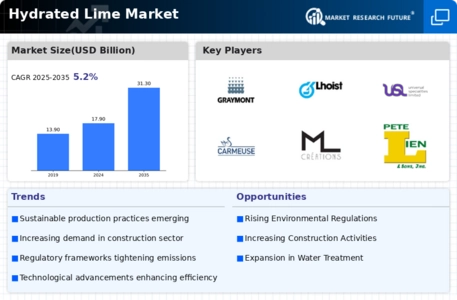Top Industry Leaders in the Hydrated Lime Market

In the Hydrated Lime Market, there's growing demand fueled by its applications in water treatment, construction, agriculture, and chemical manufacturing. Hydrated lime's ability to neutralize acidic soils, purify water, and treat industrial effluents is driving its adoption. Moreover, stringent environmental regulations regarding wastewater treatment are further propelling market growth.
Strategies Adopted:
Several key strategies are adopted by players in the hydrated lime market to gain a competitive edge:
-
Product Differentiation: Companies offer unique formulations or grades of hydrated lime catering to specific application needs, enhancing their value proposition and attracting customers seeking tailored solutions. -
Cost Leadership: Optimization of production processes, efficient sourcing of raw materials, and minimizing overhead expenses enable companies to offer competitively priced products, particularly in price-sensitive sectors. -
Market Segmentation: Dividing the market into distinct segments based on application, end-use, and region allows companies to focus their resources and develop targeted marketing strategies. -
Technological Advancements: Continuous research and development in production techniques, raw material utilization, and waste management enable the production of high-purity and sustainable hydrated lime products. -
Expansion & Acquisitions: Strategic acquisitions and geographical expansion allow companies to access new markets, diversify their product offerings, and strengthen their market presence.
Factors Affecting Market Share:
Several factors influence the market share of players in the hydrated lime market:
-
Product Quality and Consistency: Consistent production of high-quality hydrated lime that meets stringent regulatory standards is crucial for brand reputation and customer loyalty. -
Manufacturing Efficiency and Cost Optimization: Maintaining efficient production processes and minimizing costs allows companies to offer competitive pricing and generate higher profit margins. -
Distribution Network and Customer Service: A robust and well-established distribution network ensures timely delivery and efficient customer service, fostering stronger relationships with customers. -
Innovation and New Product Development: Companies that invest in research and development and offer innovative hydrated lime products with improved performance or environmental benefits can gain a competitive edge. -
Sustainability Initiatives: Implementing sustainable practices in production, packaging, and waste management aligns with growing environmental concerns and can enhance brand image.
Key Companies in the hydrated lime market include
-
Graymont
-
Lhoist
-
USLM
-
Carmeuse
-
Mississippi Lime
-
Pete Lien & Sons
-
Unimin
-
Nordkalk
-
Cape Lime (Pty) Ltd
Recent Developments
August 2023: Carmeuse Group announced the expansion of its hydrated lime production capacity at its plant in Waberns, Germany, to meet rising demand in the European construction industry.
September 2023: Lhoist Group partnered with a leading chemical company to develop a new, high-purity hydrated lime product specifically designed for use in the production of lithium-ion batteries.
October 2023: Graymont acquired a regional hydrated lime producer in North America, strengthening its presence in the region and expanding its product portfolio.
November 2023: The International Lime Association released a report highlighting the growing importance of sustainable practices in the hydrated lime industry, emphasizing the need for efficient resource utilization and reduced environmental impact.
December 2023: S.B. Minerals announced its commitment to achieving net-zero carbon emissions by 2050, outlining its plans for investing in renewable energy sources and energy-efficient production technologies.









